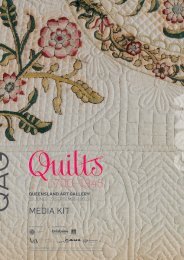1 This PowerPoint slide show is suitable for primary teachers to use ...
1 This PowerPoint slide show is suitable for primary teachers to use ...
1 This PowerPoint slide show is suitable for primary teachers to use ...
You also want an ePaper? Increase the reach of your titles
YUMPU automatically turns print PDFs into web optimized ePapers that Google loves.
Knowledge and understanding<br />
• Examine colour combinations on a colour wheel. What happens when you put<br />
certain colours alongside each other? Talk about the colours in rainbow and the<br />
order of the colours.<br />
• D<strong>is</strong>cuss different colour classifications, e.g. metallic, warm, cool or bright. How do<br />
we classify and describe colours? What colours would you select as optim<strong>is</strong>tic<br />
colours?<br />
Creating<br />
• Assemble a range of coloured items, including: paper, plastic, textiles, water, jelly<br />
and string. Encourage the students <strong>to</strong> construct colour combinations by folding,<br />
tw<strong>is</strong>ting, bending, tearing, ripping, making holes and projecting light through<br />
these objects. D<strong>is</strong>cuss the compar<strong>is</strong>ons.<br />
• Using cellophane, old film strips, transparencies, wrappers and chip packets,<br />
make three or four colour transparencies and place them on<strong>to</strong> a projec<strong>to</strong>r in a<br />
very dark room. Use th<strong>is</strong> as a backdrop <strong>for</strong> a play or s<strong>to</strong>ry. Invite the students <strong>to</strong><br />
try various d<strong>is</strong>tances and surfaces, and <strong>to</strong> vary the size by controlling the focus.<br />
Presenting<br />
• When you think of the word ‘red’ what kind of red do you see? How would you<br />
describe it? Is th<strong>is</strong> the same colour your friend sees when they think of red?<br />
Conduct a group survey in the class and evaluate which shade of red the<br />
students thought of the most.<br />
Responding<br />
• Respond <strong>to</strong> colour by words. Ask students <strong>to</strong> paint a sheet of colour and stare at<br />
it <strong>for</strong> three minutes, and without looking away, jot down their responses. What<br />
can you find in the sheet? These might be memories, images, dreams, fantasies,<br />
surreal references. Then link your words up <strong>to</strong> write a poem.<br />
Reflecting<br />
• In a very dark room, <strong>use</strong> coloured sheets and explore how the colours appear <strong>to</strong><br />
change when you project different colours on<strong>to</strong> them. You might like <strong>to</strong> project<br />
red, green and blue on<strong>to</strong> a multi-coloured sheet and see if the students can<br />
13
















